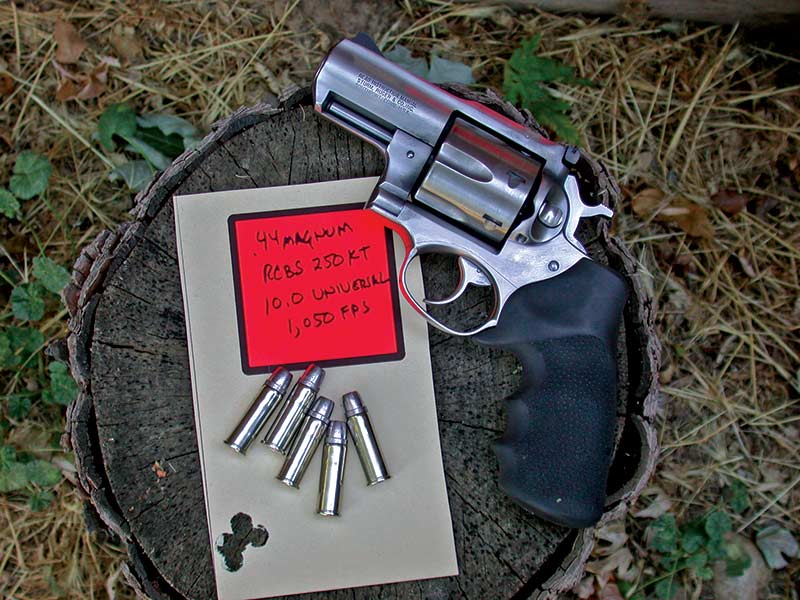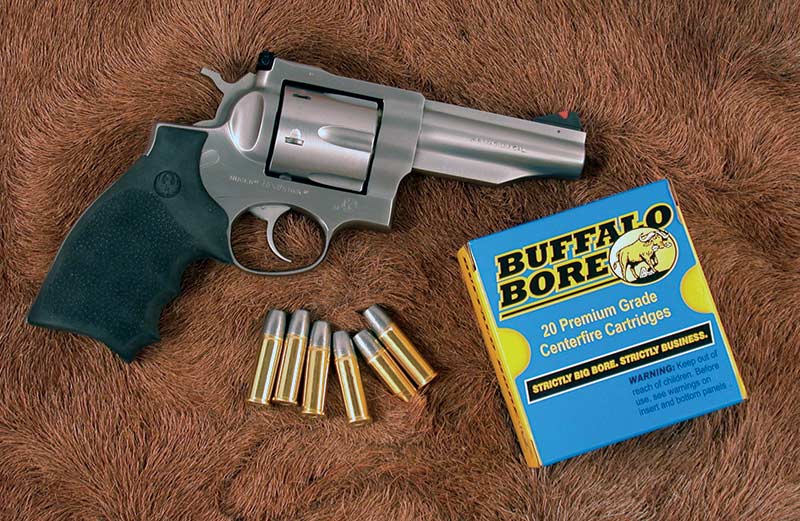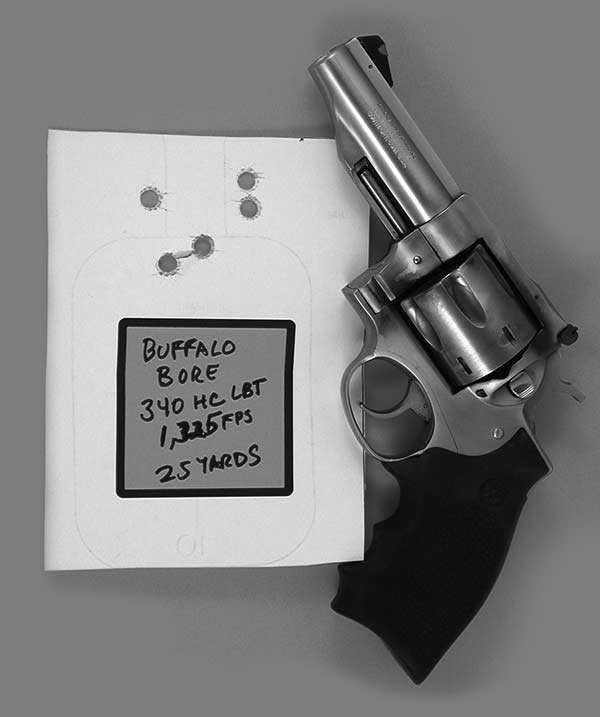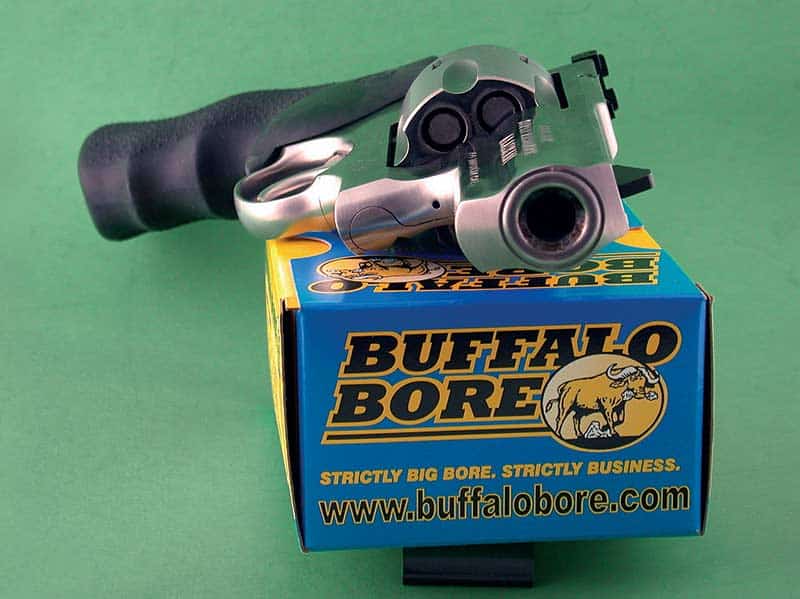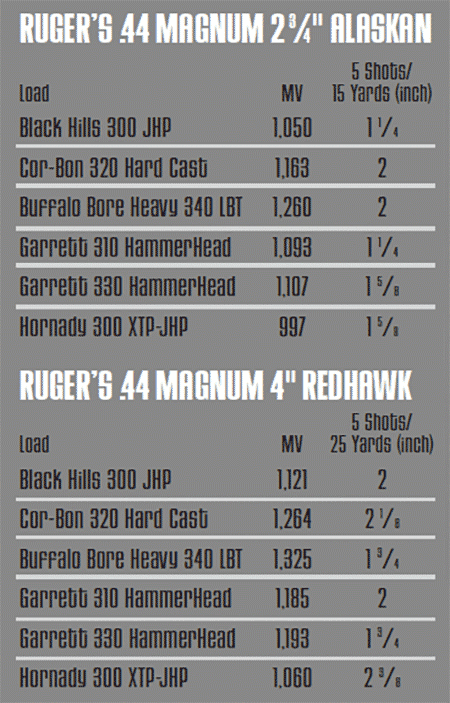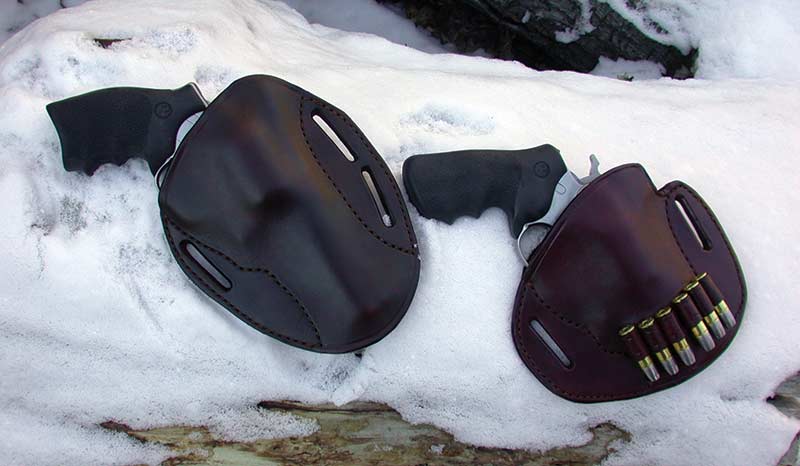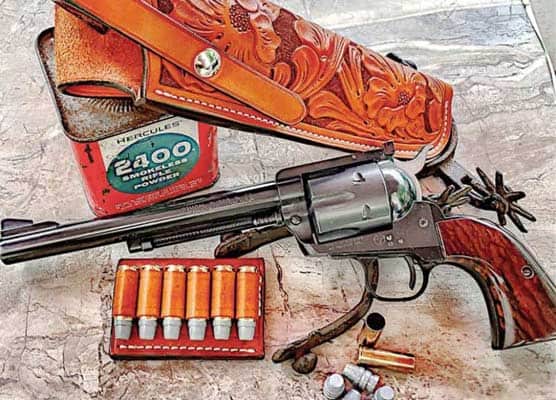Perfectly Portable And Powerful
Ruger's .44s
One or both of these double action Ruger .44 Magnums are sure to find favor with those who wander off the beaten path; or even those who simply like to spend a pleasant Saturday afternoon shooting. Ruger’s short-barreled .44 Magnums Keith — and about everybody else — wanted!
The original .44 Magnum loading consisted of a 240 grain bullet at 1,300-1,400 fps from a 4″ sixgun. Today, we not only have heavy-duty loads launching a 340 grain bullet at the same muzzle velocity, we also have heavy-duty handguns to handle them. This newer breed of sixgun is built to not only handle these loads, but to also outlast the shooter. These exceptionally strong sixguns bear the Sturm, Ruger label.
A Stronger .44
With the arrival of Clint Eastwood’s silver screen portrayal of Dirty Harry in the early 1970s, everything went cockeyed in the world of double action .44 Magnums. The demand instituted by this imaginary character created a situation which soon found S&W .44s selling as high as double the retail price, even though the Smith & Wesson factory was working around the clock to produce as many .44 Magnums as possible.
The situation would not change until Ruger joined the fray in 1979 with the 71⁄2″ stainless steel Redhawk. This first big bore DA sixgun from Ruger was larger, heavier, and stronger than the Smith & Wesson. It’s the Clydesdale to S&W’s thoroughbred. Keith, who packed a 4″ S&W .44 Magnum from 1956 until his incapacitating stroke in 1981, gave the Ruger Redhawk high praise.
“Owing to the weight of the gun and its large, comfortable grip, it’s a pleasure to shoot, and all proclaimed it was the most comfortable double action .44 Magnum they had fired. This gun came to me perfectly sighted, and with its long barrel and maximum velocity, we found it shot very well even out to rocks at 400 yards,” he said. This was written when Keith was 81 years old, and it’s obvious he had others help him with the shooting and they probably used Keith’s standard .44 Magnum loading of the 250 grain hard cast bullet over 22 grains of #2400 for about 1,400 fps.
Shorter Barrel Better
“It was accurate in the extreme, but we all cussed those hard trigger pulls …” was the one complaint he and others, myself included, had — and he also called for a 4″ version. Because of its spring set-up with the same spring powering the hammer and trigger, it has never been easy to get a light single action trigger pull on the Redhawk. However, the upside is it does smooth out with use and the double action pull is better than that found on many sixguns.
For some reason Ruger has always seemed to have an aversion for placing short barrels on .44 Magnum revolvers. The original .44 Flat-Top came standard with the shortest length being 61⁄2″. I had mine cut to 45⁄8″ in the late 1950s and Ruger made up a special 45⁄8″ Blackhawk .44 for Keith but it would never be cataloged. The 71⁄2″ Ruger Super Blackhawk .44 arrived in 1959 and it would be into the 1990s before it would be offered with a short barrel. The same held true for the Redhawk, until now.
Redhawk Fun
When I got my first Redhawk in the early 1980s I found it to be everything Keith had claimed for it, and I also found it required hard cast bullets. If wheel weights were used for casting, it was absolutely necessary to use a gas check design to prevent leading. I added several more Redhawks to my shooting battery, a 71⁄2″ .45 Colt when it became available, and with the arrival of the 51⁄2″ Redhawk, I bought both stainless steel and blued versions. The 51⁄2″ Redhawk was found to be easier to pack than the longer version, however it wasn’t quite there yet. I gave the blued .44 to my dear friend, the late Deacon Deason of BearHug Grips, and had the stainless-steel Redhawk made into a more Perfect Packin’ Pistol. My local gunsmith cut the barrel to 4″, installed a black front sight on a ramp base, and slightly round butted the grip frame and factory
Perfect Packin’
My .44 Redhawk carried oh so easily in an Idaho Leather pancake holster and handled standard .44 Magnum loads with ease. Hamilton Bowen also liked the idea of a shorter Redhawk and offered his 4″ version as “The Alpine.” For me the standard Redhawk grip frame and factory stocks worked, up to a point. The round-butt carried that level a little higher, however with the arrival of heavyweight bullets at 1,300-1,400 fps, even the modified factory grip frame and grips left something to be desired. Now Ruger has not only finally seen fit to offer a 4″ Redhawk, they have also fitted it with stocks which handle recoil much better than the originals.
Ruger Responds
Ruger’s Redhawk, at least for now, is only offered in stainless steel and chambered in .44 Magnum. Former Ruger President Steve Sanetti said this about the sixgun: “The Ruger Redhawk revolvers have long been recognized for their strength and durability, which are features .44 Magnum shooters appreciate. This .44 Magnum has only a 4″ barrel, leaving outdoor enthusiasts with no excuse to leave it at home while trekking through the woods.”
Sanetti nailed the desirability of the 4″ Redhawk .44 Magnum perfectly. This is a heavy-duty, big bore sixgun which will be taken to heart by anyone who spends much time in the desert, foothills, forests, or mountains. It will carry easy in a properly designed holster and always be ready for instant use while not requiring a lot of care.
For my use the holster of choice is by Rob Leahy of Simply Rugged. It’s a pancake style which can be worn strong side or crossdraw and is designed to fit tightly and cover most of the sixgun except for the grip, providing easy access and security without resorting to security straps.
Hogue Did It
This new Redhawk is, of course, the same basic sixgun appreciated by shooters for nearly three decades. It is all stainless-steel as the original, with a massive six-shot cylinder, and a solid frame with no sideplate. There are two major changes in addition to the
obvious shorter barrel. Instead of the interchangeable front sight system, the 4″ Redhawk has a pinned in ramp front sight with a red insert matched up with a white outline rear blade.
The stocks are hand filling, fingergrooved, Hogue rubber grips which are much more comfortable when firing heavy .44 Magnum loads. The surface of these Hogue grips are also appreciated for a much more secure feeling from their pebble grained, but nonpunishing surface, than offered by the original smooth wood grips. They aren’t the prettiest grips around but they rate 100 percent for function. Buffalo Bore’s 340-grain LBT load at 1,325 fps is all the recoil anyone should ever want, but it’s manageable in this 4″ Redhawk.
Two Is Better
Ruger didn’t stop with just one heavy-duty .44 Magnum. In 1986 Ruger introduced their second .44 Magnum double action sixgun. Instead of just changing the Redhawk and making it larger and heavier, Ruger instead used the GP-100 as the basic platform for the Super Redhawk and the plan was to drop the Redhawk as they were having some troubles with the barrel threads. The problem turned out not to be a problem at all, as it was traced to the oil being applied to the threads as the barrel was installed. Besides, the Redhawk was simply too popular to drop.
The Super Redhawk is a result of the blending of the best features of the GP-100 and the standard Redhawk. The Super Redhawk uses separate
springs for the trigger and hammer, going back to the hammer spring and strut used in their single action revolvers. This results in a much smoother trigger pull, from the box. The grip frame on the Super Redhawk is not a grip frame at all but rather a stud to accept full wrap-around stocks, and the Super Redhawk has a distinctive profile not found on any other revolver. The frame itself is extended forward of the cylinder so the first 23⁄4″ of the barrel is actually enclosed by the frame making for an even stronger arrangement.
Less Is More
When I first wrote about the Super Redhawk nearly 20 years ago I said it should be a natural for custom sixgunsmiths. By chopping the barrel of the Super Redhawk off flush with the frame, milling off the scope recesses, and fitting a front sight, the Super Redhawk would become an easily carried snub-nosed .44 Magnum. Since there is no grip frame as such, it would be very easy to make small, concealable grips for such a short barreled sixgun.
I never heard of any gunsmith doing such a project, however this is exactly what Ruger did to come up with the Alaskan chambered in .454 Casull a few years back. Then the .480 Ruger chambering was added, and now the Ruger Big Bore Trio is complete with the addition of the .44 Magnum version
Great Leather
I’ve always been one to go for fancy stocks of wood, stag, ivory, or ram’s horn. But, I must admit the rubber stocks from Hogue Grips found on the Alaskan cushion felt recoil to the point I can shoot as good and sometimes better with heavy loads than my old 4″ Redhawk with wooden ones. They do an excellent job of soaking up felt recoil.
For carrying the .44 Alaskan, I went with another Simply Rugged offering. This one is a strong side only pancake style with six cartridge loops on the holster proper allowing exceptional security and easy carrying of the Alaskan fully loaded. If the wilderness problem can’t be solved with 12 rounds, it simply can’t be solved.Where one lives, or more properly, where one wanders will determine what loads will be chosen. It can be anything from heavy .44 Special loads to standard .44 Magnum loads, up to truly heavyweight .44 Magnum loads. The accompanying chart shows results with .44 Magnum loads in the 300-grain or heavier loadings.
I’m sure Elmer would be pleased with Ruger’s offerings. I know I am.
For more info:
www.ruger-firearms.com

Get More Revolver Content Every Week!
Sign up for the Wheelgun Wednesday newsletter here:


